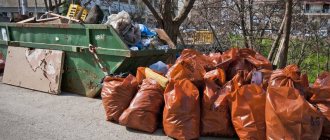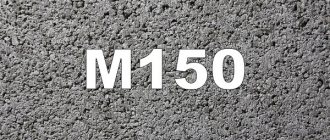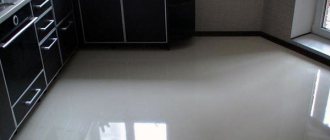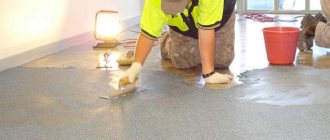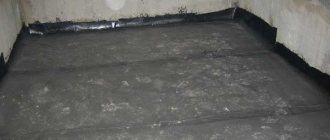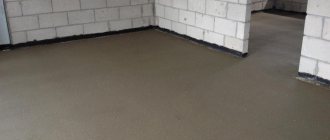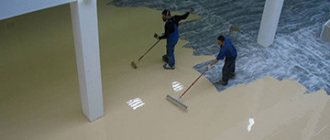To avoid problems with laying finishing materials, you need a flat, and in some cases, smooth floor. It is also often necessary to strengthen the surface and give it additional strength. Cement-sand screed copes with all these tasks perfectly. The operation is not particularly complicated, but has certain nuances.
Leveling the floor surface Source zonapola.ru
Features of cement screed
A cement-sand screed is not only a well-leveled floor lying on top of a concrete floor or brick. Using a mortar of cement and sand, a foundation is often created where there is none initially. For example, on ordinary soil.
After leveling the surface, laying the finishing floor covering becomes much easier. This is especially important when using laminate, parquet or ceramic tiles. And although the screed is called a universal subfloor, it is often used as an independent covering. But, as a rule, they do this only in utility rooms.
Some inexperienced craftsmen mistakenly equate the screed with a self-leveling floor. But the latter is distinguished by a more complex installation technology and a wealth of components. In addition, any self-leveling floor requires a prepared surface. And this role is played by a separate cement screed.
Self-leveling polymer floor Source m.asninfo.ru
Leveling the horizontal plane is only one of the main tasks when arranging the floor. Filling with cement mortar creates a reliable and durable foundation. Which also acts as an excellent stabilizer of humidity and temperature. And this significantly increases the comfort in the room.
The construction of a cement-sand screed often includes various communications. The installation of heating elements is very common. “Warm floor” serves as an excellent addition to the main heating when the temperature outside the window drops especially low.
The thickness of the poured layer starts from three centimeters. The maximum value can theoretically be anything. But since the weight of the cement-sand screed is considerable, they try to lay no more than 8 cm of mortar on the floors. And to prevent the surface from cracking, the base should not vibrate.
Thickness of screed based on cement and sand Source cement-i-smesi.ru
Advantages of floor screed:
- The ability to give the floor almost perfect evenness.
- The service life of such a surface reaches 50 years.
- The floor can withstand significant loads.
- Possibility to hide any engineering communications from sight.
- The cement layer does not conduct sounds well. And if you put additional insulation underneath, the noise reduction increases significantly.
- The same can be said about thermal insulation.
- The shrinkage rates of the screed during hardening are extremely low.
- Acts as a low-budget technology.
Serious disadvantages include the large mass of the coating. The weight of cement-sand screed per 1 m² reaches twenty kilograms with a layer of only one centimeter. This is a significant obstacle when it comes to leveling floor slabs. But if work is carried out on the ground, then the thickness of the layer practically does not matter.
See also: Catalog of companies that specialize in finishing materials and related work
No. 6. Large manufacturers
The manufacturer is responsible for the quality of the product with its reputation. If you want to be sure that the proportions are correct and the indicated consumption is adequate, then it is better to buy mixtures from trusted manufacturers. Among the largest we note the following:
- Knauf is a German company that, among other things, produces dry building mixtures. For floor screed there is a cement and universal gypsum-cement self-leveling screed. The cement composition costs about 500 rubles. for 25 kg;
- Ceresit produces a wide range of cement and gypsum compositions. The universal composition CN 175 will cost approximately 400 rubles. for 25 kg, and self-leveling mixture DD for creating screed with a layer of up to 5 mm - 850 rubles;
- Bergauf produces a lot of solutions for roughing and finishing floors. For basic leveling, Base mixtures (about 230 rubles for 25 kg) and Erste Grund are suitable; for finishing you can use Easy Final (300 rubles) and Boden Nivelir, there are self-leveling mixtures;
- Osnovit is one of the most famous domestic manufacturers, producing rough, finishing and high-strength compositions, as well as mixtures for use with heated floors. Prices are moderate. A 25 kg bag of FC44 M mixture costs about 175-220 rubles;
- Unis offers the widest range of floor screed mixtures. There are roughing and finishing compositions, reinforcing and quickly hardening mixtures, as well as self-leveling and high-strength compositions. A 25 kg bag of mixture for rough work will cost 205 rubles.
It is also worth noting the products of the brands Ilmax, Ivsil, “Poligran” and “Sarmat ”. It doesn’t hurt to look online before purchasing and read reviews about the specific composition of a particular manufacturer.
Types of screeds
The simplest type is called base-related. Because the cement mortar is laid directly on the floor slab. And in addition to leveling in the horizontal plane, the base is strengthened. The slab is dust free and must be primed. The latter will protect the solution from dehydration. The layer thickness should not be less than 3 cm.
Types of floor screeds Source siteapi.org
If waterproofing is laid between the base and the screed, then the minimum thickness increases to 4 cm. A separating layer is needed in two cases. When it is not possible to prime the base or there is an increased risk that the solution will dry faster than the standards provided for by the technology. The material most often used is a polyethylene membrane.
For residential premises, as a rule, a floating screed is used. In this case, the cement mortar is separated from the base by a layer of various insulation. The latter serves both for noise reduction and for maintaining heat in the room. If reinforcing mesh is used, the layer thickness can be within five centimeters. Without reinforcement, the minimum layer should be at least 7 cm.
Fill
To reduce water absorption of the base and dry out too quickly, the base is carefully primed.
Pouring does not require any special skills, the main thing is to follow a few simple rules. First: you don’t need to add a lot of water to the batch. There should be enough water so that the solution can be easily leveled. For greater plasticity, you can add liquid soap (feri) - 1-2 tablespoons per bucket of water.
It will also be useful for you to learn: “Why cracks form on the screed, how to avoid it.”
When leveling the solution, voids and empty hard-to-reach places should be avoided. To remove air, use a trowel or trowel, piercing the thickness of the solution. Avoid breaks between batches of more than 30 minutes; the joint between the old and new mortar will be weak.
Do not forget: where the layer is less than 30 mm, you need to use special mixtures, self-leveling floors, which are declared by the manufacturer for thinner layers.
It would be a good idea to grease the places of the “cakes” from the beacons with PVA glue. In general, it should be understood: delaminations can form at all joints of fresh and dried or setting mortar. These seams should be kept to a minimum if possible.
When pouring expanded clay concrete, first cement is added to the water, and then expanded clay. Only after the expanded clay has been soaked is sand introduced into the solution. The first layer is laid the main mass, which does not reach the level of the beacons 1-2 centimeters, the second layer without expanded clay is laid the missing solution. There should also be no breaks of more than 30 minutes between layers. When laying the top layer, expanded clay stones may float up, so as not to spoil anything, you should not pay attention to them. After setting, the protruding stones are cut off using a rule.
The next day, when the screed has set, all small irregularities and sagging are usually cut off. The screed is swept out and primed. It will not be a bad idea to water the surface with a small amount of water for several days.
Proportions and calculations
For a regular screed, it is enough to take cement grade 400 and add 3 parts of sand to one part of it. Water must be added until the solution reaches a creamy state. Moreover, it is positioned as thick and tough. Excess water will lead to deterioration in quality.
Proportions of materials for screed Source oboiman.ru
Conclusion
In some situations, the only correct solution was and remains a conventional screed using the wet method as it best meets the conditions of use. And nothing can be done about the phlegm, dirt and other associated inconveniences. In places where increased loads and dancing for days on end are not envisaged, dry screed and its variations can be a worthy alternative.
Dry screed is one of the suitable types of base for an infrared film floor, which is described in the article “Infrared heated floor - from theory to practice.” To prevent the heat retained by the floor from escaping through the windows, read the article about do-it-yourself wooden Euro-windows. In a video about working with floors and walls, a specialist will demonstrate a light screed device.
Subscribe to our Telegram channel Exclusive posts every week
Step-by-step execution
The whole process can be divided into stages:
- The base is cleaned and primed. The insulation is distributed. A waterproofing membrane is laid on top of it. The pieces are overlapped, and all seams are taped to ensure a tight seal.
- The plastic film should extend onto the walls by ten centimeters. It is attached to them with polystyrene foam tape, 1 to 2 cm thick. You can use foam inserts.
- The general level of the entire screed is set. The easiest way is to use a laser level. If it is not there, then marks on the walls are made using a water level.
- Beacons are installed based on the marks made. A strong material (pipe, corner or profile) is selected for them. Place them on piles of mortar and level them at the same level in a horizontal plane.
- Pouring the cement-sand mixture begins from the far corner. Leveling the solution between the beacons as a rule, they gradually move towards the door. The mixture is added in the right places.
Distribution of the finished mortar over the area Source stroikairemont.com
Rating of floor screeds
When compiling the review, mixtures of domestic manufacturers and foreign brands were analyzed. The compliance of the solutions with the declared characteristics, compositional features, and specifics of work were studied. Feedback from property owners and the opinions of professional builders were taken into account. Particular attention was paid to the following characteristics:
- Scope of application - they produce compositions for external and internal work;
- Thickness – produce thin-layer, thick-layer and universal mixtures;
- Drying time – affects the finishing rate;
- Viability – the lifespan of a solution under normal conditions;
- Additional properties - the presence of fillers improves sound and heat insulation.
Inconsistency with the declared brand, excess sand, insufficient weight in the bag - products with such shortcomings were excluded from our rating.
Preventive action
A large area of the screed will inevitably crack in the future under temperature and mechanical stress. To avoid such problems, expansion joints are used. To do this, shallow slits are cut out in the still uncured solution.
The entire area of the room is divided into small sections. And the width between the seams should be between 3 and 4 meters. And in long and narrow rooms this figure decreases to 2. Seams are extremely necessary in the area of passages from room to room.
If a board or laminate is used as a finishing coating, then the cracks can be left empty. When tiling, the seams are filled with sealant. Otherwise, they will take all the moisture from the solution. And when screeding for “warm floors,” it is necessary to use reinforcing fiber and plasticizers.
Briefly about the main thing
The advent of ready-made mixtures for screed construction has greatly facilitated the work of builders and made their results better. Among them you can find compositions suitable for various purposes - pouring a subfloor, installing a smooth coating under linoleum or parquet, creating a heated floor system, etc. But homemade floor screed solutions made from a mixture of sand and cement also remain relevant. Their strength is quite sufficient for residential buildings and utility rooms, and the cost is significantly lower.
How many bags of dry mix are needed for a screed thickness of 5 cm using M300 as an example?
The consumption of dry mixture per 1 m2 of screed can be calculated in another way. To do this, the basis is not kilograms of material, but the number of bags in which it is packed.
Manufacturers today offer dry mixes for screeds, packaged in paper bags of 40 or 50 kg. In our case, 1200 kg of sand concrete is required. If these are 40-kilogram bags, then their quantity is determined as follows:
1200: 40 = 30 bags.
If these are 50 kg bags, then the quantity will be: 1200: 50 = 24 pieces.
Online calculators
Today, a large number of Internet services offer calculators with which you can quickly calculate the required amount of dry mixtures.
They can be used, but taking into account the fact that there is no exact data on what scheme the mathematical calculations are made according to, and what material consumption per 1 cm of thickness was included in the program.
For example, when calculating sand concrete M300 with a consumption per 1 m2, calculators for floor screed at different services showed different values. And this confirms that the program included indicators from different manufacturing companies.
It’s easier to look at the packaging, where this parameter is indicated. And take it as a basis. Next, carry out all the calculations yourself according to the formulas indicated above. It will be faster and more reliable.
